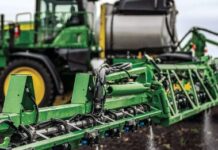Contact: Bill Meyer
August 31, 2020 (800) 392-3202
CROP PROGRESS AND CONDITION
WEEK ENDING AUGUST 30, 2020
AGRICULTURAL SUMMARY: Crops continued to mature quickly and barley harvest made good progress last week, according to the Mountain Region Field Office of the National Agricultural Statistics Service, USDA. Northwestern counties received isolated moisture, but overall pasture conditions continued to suffer from lack of consistent precipitation and hot weather. In northeastern counties, scattered precipitation and cooler temperatures brought short-term relief in areas. Overall, conditions remained very dry. County reports noted increased incidence of non-irrigated crop failure as well as supplemental feeding of livestock. Livestock producers were selling calves early and continued to pull stock off summer grazing. Crop producers were preparing for corn silage and sugarbeet harvest. In east central counties, some localities received precipitation last week. Most areas remained hot, dry, and windy. County reports noted condition of non-irrigated corn varied widely in the district. Livestock producers were providing supplemental feed in the absence of native grass. According to the latest U.S. Drought Monitor report, exceptional drought conditions were present in Kiowa county. Local reports noted increased crop abandonment was expected in the county and producers were very concerned regarding the lack of moisture for seeding winter wheat. In the San Luis Valley, barley harvest advanced quickly although isolated moisture late in the week caused a few delays. Received moisture will benefit pastures, but more is needed. In southeastern counties, scattered rain was received. A county report noted corn in the area had problems pollinating due to extreme heat. Statewide, stored feed supplies were rated 11 percent very short, 33 percent short, 53 percent adequate, and 3 percent surplus. Sheep death loss was 70 percent average and 30 percent light. Cattle death loss was 89 percent average and 11 percent light.
CROP AND LIVESTOCK PROGRESS
| Commodity | Current week | Previous week | Previous year | 5-year average |
| (percent) | (percent) | (percent) | (percent) | |
| Alfalfa hay
3rd cutting harvested …………………………………… |
54 |
42 |
48 |
55 |
| 4th cutting harvested …………………………………… | 3 | NA | 9 | NA |
| Barley
Harvested …………………………………………………. |
84 |
61 |
71 |
69 |
| Corn
Doughed …………………………………………………… |
86 |
70 |
67 |
78 |
| Dented ……………………………………………………… | 39 | 23 | 19 | 37 |
| Mature ……………………………………………………… | 4 | — | 1 | 1 |
| Harvested for silage …………………………………… | 14 | 6 | 9 | 13 |
| Dry edible beans
Cut ………………………………………………………….. |
7 |
1 |
1 |
10 |
| Onions
Harvested …………………………………………………. |
6 |
4 |
1 |
17 |
| Potatoes inside San Luis Valley
Harvested …………………………………………………. |
6 |
3 |
6 |
4 |
| Potatoes outside San Luis Valley
Harvested …………………………………………………. |
13 |
5 |
13 |
22 |
| Proso Millet
Harvested …………………………………………………. |
3 |
NA |
NA |
NA |
| Sorghum
Headed …………………………………………………….. |
91 |
86 |
92 |
92 |
| Turning color ……………………………………………. | 39 | 16 | 16 | 37 |
| Mature ……………………………………………………… | 8 | — | 1 | 1 |
NA – not available
(–) – zero
DAYS SUITABLE FOR FIELDWORK AND SOIL MOISTURE CONDITION
| Current week | Previous week | Previous year | 5-year average | |
| Days suitable for fieldwork ………………………………
|
6.6
|
6.9
|
6.6
|
6.6
|
| Topsoil moisture | (percent) | (percent) | (percent) | (percent) |
| Very short ………………………………………………… | 46 | 39 | 4 | 5 |
| Short ……………………………………………………….. | 36 | 44 | 24 | 25 |
| Adequate …………………………………………………. | 18 | 17 | 68 | 68 |
| Surplus…………………………………………………….. | — | — | 4 | 2 |
| Subsoil moisture
Very short ………………………………………………… |
43 |
43 |
4 |
6 |
| Short ……………………………………………………….. | 39 | 42 | 22 | 23 |
| Adequate …………………………………………………. | 18 | 15 | 70 | 69 |
| Surplus…………………………………………………….. | — | — | 4 | 2 |
NA – not available
(–) – zero
NASS provides accurate, timely, and useful statistics in service to U.S. agriculture. We invite you to provide occasional feedback on our products and services. Sign up at http:/usda.mannlib.cornell.edu/subscriptions and look for “NASS Data User Community.” USDA is an equal opportunity provider, employer and lender. To file a complaint of discrimination, write: USDA, Director, Office of Civil Rights, 1400 Independence Ave., S.W., Washington, D.C. 20250-9410 or call (800) 795-3272 (voice), or (202) 720-6382 (TDD).
CROP, LIVESTOCK, PASTURE AND RANGE CONDITION
| Commodity | Current week | Previous week | Previous year | 5-year average |
| (percent) | (percent) | (percent) | (percent) | |
| Alfalfa hay
Very poor …………………………………………………. |
10 |
10 |
3 |
2 |
| Poor …………………………………………………………. | 12 | 18 | 5 | 7 |
| Fair ………………………………………………………….. | 28 | 20 | 7 | 20 |
| Good ……………………………………………………….. | 43 | 45 | 76 | 61 |
| Excellent ………………………………………………….. | 7 | 7 | 9 | 10 |
| Corn
Very poor …………………………………………………. |
26 |
19 |
— |
1 |
| Poor …………………………………………………………. | 18 | 18 | 2 | 5 |
| Fair ………………………………………………………….. | 25 | 24 | 15 | 22 |
| Good ……………………………………………………….. | 27 | 32 | 64 | 60 |
| Excellent ………………………………………………….. | 4 | 7 | 19 | 12 |
| Dry edible beans
Very poor …………………………………………………. |
3 |
3 |
1 |
1 |
| Poor …………………………………………………………. | 23 | 22 | 5 | 8 |
| Fair ………………………………………………………….. | 41 | 41 | 19 | 24 |
| Good ……………………………………………………….. | 32 | 33 | 63 | 58 |
| Excellent ………………………………………………….. | 1 | 1 | 12 | 9 |
| Onions
Very poor …………………………………………………. |
3 |
3 |
— |
2 |
| Poor …………………………………………………………. | 6 | 6 | — | 5 |
| Fair ………………………………………………………….. | 24 | 24 | 1 | 12 |
| Good ……………………………………………………….. | 62 | 62 | 98 | 72 |
| Excellent ………………………………………………….. | 5 | 5 | 1 | 9 |
| Pasture and range
Very poor …………………………………………………. |
26 |
22 |
3 |
6 |
| Poor …………………………………………………………. | 31 | 42 | 5 | 12 |
| Fair ………………………………………………………….. | 36 | 27 | 18 | 23 |
| Good ……………………………………………………….. | 6 | 8 | 66 | 51 |
| Excellent ………………………………………………….. | 1 | 1 | 8 | 8 |
| Potatoes inside San Luis Valley
Very poor …………………………………………………. |
2 |
2 |
— |
— |
| Poor …………………………………………………………. | 6 | 5 | 3 | 4 |
| Fair ………………………………………………………….. | 20 | 17 | 30 | 17 |
| Good ……………………………………………………….. | 50 | 53 | 47 | 56 |
| Excellent ………………………………………………….. | 22 | 23 | 20 | 23 |
| Potatoes outside San Luis Valley
Very poor …………………………………………………. |
— |
2 |
— |
— |
| Poor …………………………………………………………. | 5 | 7 | 2 | 1 |
| Fair ………………………………………………………….. | 20 | 23 | 16 | 10 |
| Good ……………………………………………………….. | 60 | 56 | 69 | 76 |
| Excellent ………………………………………………….. | 15 | 12 | 13 | 13 |
| Sorghum
Very poor …………………………………………………. |
20 |
16 |
1 |
2 |
| Poor …………………………………………………………. | 23 | 26 | 3 | 5 |
| Fair ………………………………………………………….. | 40 | 45 | 14 | 23 |
| Good ……………………………………………………….. | 15 | 9 | 69 | 64 |
| Excellent ………………………………………………….. | 2 | 4 | 13 | 6 |
| Sugarbeets
Very poor …………………………………………………. |
9 |
5 |
— |
— |
| Poor …………………………………………………………. | 11 | 9 | 1 | 2 |
| Fair ………………………………………………………….. | 24 | 24 | 10 | 13 |
| Good ……………………………………………………….. | 48 | 52 | 82 | 71 |
| Excellent ………………………………………………….. | 8 | 10 | 7 | 14 |
| Sunflowers
Very poor …………………………………………………. |
7 |
7 |
— |
— |
| Poor …………………………………………………………. | 33 | 28 | 1 | 2 |
| Fair ………………………………………………………….. | 43 | 46 | 11 | 22 |
| Good ……………………………………………………….. | 16 | 19 | 76 | 68 |
| Excellent …………………………………………………..
|
1
|
— | 12
|
8
|
| Livestock
Very poor …………………………………………………. |
4 |
3 |
— |
— |
| Poor …………………………………………………………. | 8 | 8 | 2 | 1 |
| Fair ………………………………………………………….. | 32 | 35 | 6 | 11 |
| Good ……………………………………………………….. | 47 | 46 | 82 | 78 |
| Excellent ………………………………………………….. | 9 | 8 | 10 | 10 |
NA – not available
(–) – zero




